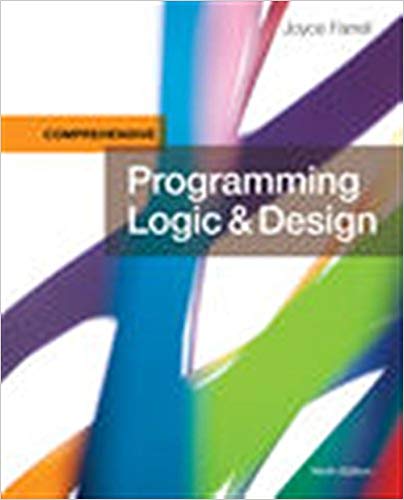Instruction Manual for Programming Logic and Design Comprehensive 9th edition by Joyce Farrell ISBN 1337517046 9781337517041
$70.00 Original price was: $70.00.$35.00Current price is: $35.00.
Instant download (Instruction Manual) Programming Logic and Design Comprehensive 9th edition after payment
Instruction Manual for Programming Logic and Design Comprehensive 9th edition by Joyce Farrell – Ebook PDF Instant Download/Delivery: 1337517046, 9781337517041
Full download Programming Logic and Design Comprehensive 9th edition after payment

Product details:
ISBN 10: 1337517046
ISBN 13: 9781337517041
Author: Joyce Farrell
Prepare for programming success as you learn the fundamental principles of developing structured program logic with Farrell’s fully revised PROGRAMMING LOGIC AND DESIGN, COMPREHENSIVE, 9E. Ideal for mastering foundational programming, this popular book takes a unique, language-independent approach to programming with a distinctive emphasis on modern conventions. Noted for its clear writing style and complete coverage, the book eliminates highly technical jargon while introducing you to universal programming concepts and encouraging a strong programming style and logical thinking. Frequent side notes and Quick Reference boxes provide concise explanations of important programming concepts. Each chapter also contains learning objectives, a concise summary, and a helpful list of key terms. End-of-chapter material ensures your comprehension with multiple-choice review, programming and debugging exercises, and a maintenance exercise that encourages you to improve working logic.
Programming Logic and Design Comprehensive 9th Table of contents:
Sure! Below is the text reformatted according to the table of contents format:
Table of Contents
Chapter 1: An Overview of Computers and Programming
- Understanding Computer Systems
- Understanding Simple Program Logic
- Understanding the Program Development Cycle
- Understanding the Problem
- Planning the Logic
- Coding the Program
- Using Software to Translate the Program into Machine Language
- Testing the Program
- Putting the Program into Production
- Maintaining the Program
- Using Pseudocode Statements and Flowchart Symbols
- Writing Pseudocode
- Drawing Flowcharts
- Repeating Instructions
- Using a Sentinel Value to End a Program
- Understanding Programming and User Environments
- Understanding Programming Environments
- Understanding User Environments
- Understanding the Evolution of Programming Models
- Chapter Summary
- Key Terms
- Exercises
Chapter 2: Elements of High-Quality Programs
- Declaring and Using Variables and Constants
- Understanding Data Types
- Understanding Unnamed, Literal Constants
- Working with Variables
- Understanding a Declaration’s Data Type
- Understanding a Declaration’s Identifier
- Assigning Values to Variables
- Declaring Named Constants
- Performing Arithmetic Operations
- The Integer Data Type
- Understanding the Advantages of Modularization
- Modularization Provides Abstraction
- Modularization Helps Multiple Programmers to Work on a Problem
- Modularization Allows You to Reuse Work
- Modularizing a Program
- Declaring Variables and Constants within Modules
- Understanding the Most Common Configuration for Mainline Logic
- Creating Hierarchy Charts
- Features of Good Program Design
- Using Program Comments
- Choosing Identifiers
- Designing Clear Statements
- Writing Clear Prompts and Echoing Input
- Maintaining Good Programming Habits
- Chapter Summary
- Key Terms
- Exercises
Chapter 3: Understanding Structure
- The Disadvantages of Unstructured Spaghetti Code
- Understanding the Three Basic Structures
- The Sequence Structure
- The Selection Structure
- The Loop Structure
- Combining Structures
- Using a Priming Input to Structure a Program
- Understanding the Reasons for Structure
- Recognizing Structure
- Structuring and Modularizing Unstructured Logic
- Chapter Summary
- Key Terms
- Exercises
Chapter 4: Making Decisions
- The Selection Structure
- Using Relational Comparison Operators
- Avoiding a Common Error with Relational Operators
- Understanding AND Logic
- Nesting AND Decisions for Efficiency
- Using the AND Operator
- Avoiding Common Errors in an AND Selection
- Understanding OR Logic
- Writing OR Selections for Efficiency
- Using the OR Operator
- Avoiding Common Errors in an OR Selection
- Understanding NOT Logic
- Avoiding a Common Error in a NOT Expression
- Making Selections within Ranges
- Avoiding Common Errors When Using Range Checks
- Understanding Precedence When Combining AND and OR Operators
- Understanding the Case Structure
- Chapter Summary
- Key Terms
- Exercises
Chapter 5: Looping
- Appreciating the Advantages of Looping
- Using a Loop Control Variable
- Using a Definite Loop with a Counter
- Using an Indefinite Loop with a Sentinel Value
- Understanding the Loop in a Program’s Mainline Logic
- Nested Loops
- Avoiding Common Loop Mistakes
- Mistake: Failing to Initialize the Loop Control Variable
- Mistake: Neglecting to Alter the Loop Control Variable
- Mistake: Using the Wrong Type of Comparison When Testing the Loop Control Variable
- Mistake: Including Statements Inside the Loop Body that Belong Outside the Loop
- Using a for Loop
- Using a Posttest Loop
- Recognizing the Characteristics Shared by Structured Loops
- Common Loop Applications
- Using a Loop to Accumulate Totals
- Using a Loop to Validate Data
- Limiting a Reprompting Loop
- Validating a Data Type
- Validating Reasonableness and Consistency of Data
- Comparing Selections and Loops
- Chapter Summary
- Key Terms
- Exercises
Chapter 6: Arrays
- Storing Data in Arrays
- How Arrays Occupy Computer Memory
- How an Array Can Replace Nested Decisions
- Using Constants with Arrays
- Using a Constant as the Size of an Array
- Using Constants as Array Element Values
- Using a Constant as an Array Subscript
- Searching an Array for an Exact Match
- Using Parallel Arrays
- Improving Search Efficiency
- Searching an Array for a Range Match
- Remaining within Array Bounds
- Understanding Array Size
- Understanding Subscript Bounds
- Using a for Loop to Process an Array
- Chapter Summary
- Key Terms
- Exercises
Chapter 7: File Handling and Applications
- Understanding Computer Files
- Organizing Files
- Understanding the Data Hierarchy
- Performing File Operations
- Declaring a File Identifier
- Opening a File
- Reading Data from a File and Processing It
- Writing Data to a File
- Closing a File
- A Program that Performs File Operations
- Understanding Control Break Logic
- Merging Sequential Files
- Master and Transaction File Processing
- Random Access Files
- Chapter Summary
- Key Terms
- Exercises
Chapter 8: Advanced Data Handling Concepts
- Understanding the Need for Sorting Data
- Using the Bubble Sort Algorithm
- Understanding Swapping Values
- Understanding the Bubble Sort
- Sorting Multifield Records
- Sorting Data Stored in Parallel Arrays
- Sorting Records as a Whole
- Other Sorting Algorithms
- Using Multidimensional Arrays
- Using Indexed Files and Linked Lists
- Using Indexed Files
- Using Linked Lists
- Chapter Summary
- Key Terms
- Exercises
Chapter 9: Advanced Modularization Techniques
- The Parts of a Method
- Using Methods with No Parameters
- Creating Methods that Require Parameters
- Creating Methods that Require Multiple Parameters
- Creating Methods that Return a Value
- Using an IPO Chart
- Passing an Array to a Method
- Overloading Methods
- Avoiding Ambiguous Methods
- Using Predefined Methods
- Method Design Issues: Implementation Hiding, Cohesion, and Coupling
- Understanding Implementation Hiding
- Increasing Cohesion
- Reducing Coupling
- Understanding Recursion
- Chapter Summary
- Key Terms
- Exercises
Chapter 10: Object-Oriented Programming
- Principles of Object-Oriented Programming
- Classes and Objects
- Polymorphism
- Inheritance
- Encapsulation
- Defining Classes and Creating Class Diagrams
- Creating Class Diagrams
- The Set Methods
- The Get Methods
- Work Methods
- Understanding Public and Private Access
- Organizing Classes
- Understanding Instance Methods
- Understanding Static Methods
- Using Objects
- Passing an Object to a Method
- Returning an Object from a Method
- Using Arrays of Objects
- Chapter Summary
- Key Terms
- Exercises
Chapter 11: More Object-Oriented Programming Concepts
- Understanding Constructors
- Default Constructors
- Non-default Constructors
- Overloading Instance Methods and Constructors
- Understanding Destructors
- Understanding Composition
- Understanding Inheritance
- Understanding Inheritance Terminology
- Accessing Private Fields and Methods of a Parent Class
- Overriding Parent Class Methods in a Child Class
- Using Inheritance to Achieve Good Software Design
- An Example of Using Predefined Classes: Creating GUI Objects
- Understanding Exception Handling
- Drawbacks to Traditional Error-Handling Techniques
- The Object-Oriented Exception-Handling Model
- Using Built-in Exceptions and Creating Your Own Exceptions
- Reviewing the Advantages of Object-Oriented Programming
- Chapter Summary
- Key Terms
- Exercises
Chapter 12: Event-Driven GUI Programming, Multithreading, and Animation
- Understanding Event-Driven Programming
- User-Initiated Actions and GUI Components
- Designing Graphical User Interfaces
- The Interface Should Be Natural and Predictable
- The Interface Should Be Attractive, Easy to Read, and Nondistracting
- To Some Extent, It’s Helpful If the User Can Customize Your Applications
- The Program Should Be Forgiving
- The GUI Is Only a Means to an End
- Developing an Event-Driven Application
- Creating Wireframes
- Creating Storyboards
- Defining the Storyboard Objects in an Object Dictionary
- Defining Connections Between the User Screens
- Planning the Logic
- Understanding Threads and Multithreading
- Creating Animation
- Chapter Summary
- Key Terms
- Exercises
Appendix A: Understanding Numbering Systems and Computer Codes
Appendix B: Solving Difficult Structuring Problems
Glossary
Index
People also search for Programming Logic and Design Comprehensive 9th :
programming logic and design comprehensive 9th edition
programming logic and design comprehensive 9th edition answer key
programming logic and design comprehensive 9th edition pdf
programming logic and design comprehensive 8th edition
programming logic and design 9th edition
Tags:
Joyce Farrell,Programming Logic,Design Comprehensive


